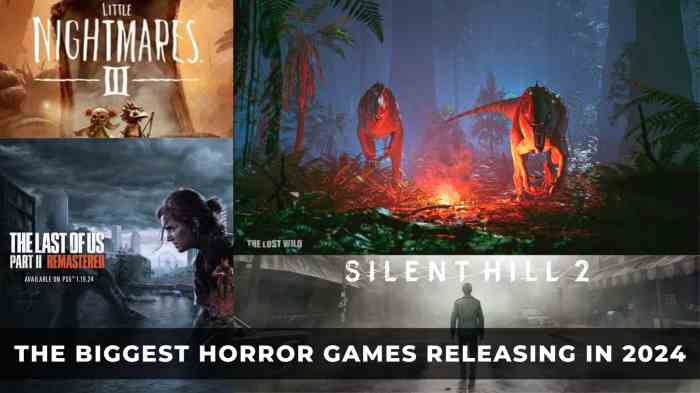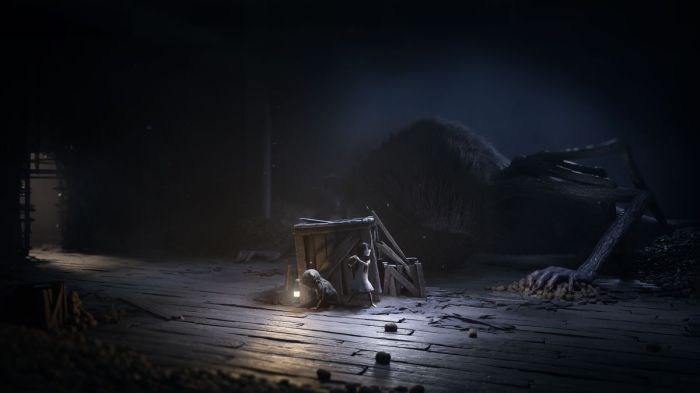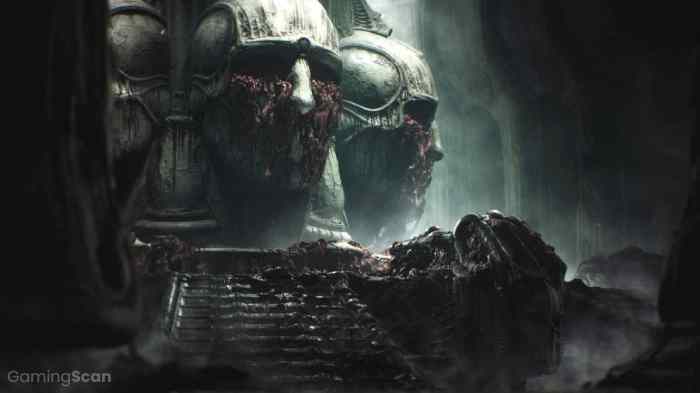Horror game 2025 unique gameplay experiences promise a thrilling evolution in the genre. From innovative mechanics to immersive narratives, the next generation of fright will push boundaries and redefine what it means to be terrified. Emerging technologies, like VR and AR, are poised to reshape the very fabric of the horror experience, while sophisticated storytelling and player agency will become key components in crafting truly unforgettable encounters.
This exploration delves into the predicted trends, examining the potential of unique gameplay mechanics, innovative narrative structures, and the crucial role of technical advancements in crafting the terrifying adventures of 2025. Prepare for a deep dive into the future of fear.
Unique Gameplay Mechanics

The year is 2025. Horror games are evolving beyond jump scares and predictable traps. Players crave experiences that challenge their wits, test their resilience, and push the boundaries of interactive storytelling. This evolution necessitates a shift towards innovative gameplay mechanics, offering a fresh perspective on the genre. The future of horror gaming demands a more profound connection between player action and narrative consequence.
Innovative Gameplay Mechanics for 2025 Horror Games
A new era of horror games is emerging, demanding gameplay mechanics that go beyond the familiar. These mechanics will immerse players in unsettling environments, forcing them to confront not only the monsters but also their own fears and decisions. Unique mechanics create unpredictable scenarios and demand players to think critically to survive.
- Environmental Storytelling through Interaction: Players will no longer just observe the environment; they will actively shape it. Interacting with objects, manipulating the layout, and triggering hidden events will unveil crucial narrative details and alter the path of the story. For instance, moving a heavy object might reveal a secret passage, or altering a circuit could unleash a previously dormant threat.
- Dynamically Shifting Terror: The game world will react to player actions in unexpected ways. A character’s fear could influence the actions of enemies, making them more aggressive or changing their hunting patterns. The weather, sounds, and even the very layout of the environment could adapt to the player’s movements and decisions, amplifying the sense of dread and creating an ever-shifting, ever-present threat. This could manifest in storms escalating during a chase or a predator’s heightened senses responding to the player’s heightened awareness.
- Psychological Horror through Choices: Players will make moral dilemmas, choices that will shape not only their survival but also the narrative. These choices will alter the behavior of NPCs, influence the appearance of the environment, and directly impact the overall story. For example, a choice to confront a hostile character could result in the protagonist being ostracized by the remaining survivors, leading to a more isolating and harrowing experience.
Player Agency and Narrative Shaping
The role of the player in shaping the narrative is crucial. Players are no longer passive observers; they are active participants in the story. Their choices, actions, and reactions will directly influence the narrative’s progression and the ultimate outcome. This emphasizes the importance of player agency, ensuring that their experience feels personal and meaningful.
- Branching Narrative Paths: Players’ choices will lead to different outcomes, creating a variety of endings and experiences. This could manifest in a game where choosing to help or betray a group of survivors could result in radically different endings, reflecting the morality of the choices made.
- Emergent Storytelling: The game will dynamically respond to player actions, creating unexpected narrative twists and turns. This element of unpredictability adds to the horror by showing that the game is not merely a series of pre-scripted events, but a living, breathing entity reacting to the choices and actions of the player.
Integration into Different Horror Genres
The core mechanics of horror games can be adapted to diverse genres. The key is to blend the core gameplay mechanics with the genre’s unique atmosphere and tone.
| Horror Genre | Potential Gameplay Mechanics |
|---|---|
| Psychological Horror | Environmental storytelling, dynamically shifting terror, psychological horror through choices. |
| Survival Horror | Resource management tied to environmental storytelling, dynamic enemy behavior, and the importance of player agency in resource allocation and crafting. |
| Creature Feature | Dynamic environments reacting to player actions and choices, leading to different monster encounters. |
Emergent Gameplay Design
Emergent gameplay in horror games involves designing systems that allow for unpredictable and emergent events, based on player actions. This approach requires a careful balance between pre-designed scenarios and flexible systems that adapt to player input. It enhances the feeling of a living, breathing world.
- Randomized Encounters: Implementing randomized encounters based on player choices and environmental conditions. For example, a choice to explore a specific area could trigger a unique monster encounter not seen in other playthroughs.
- Dynamic NPC Behavior: Programming NPCs to react realistically to player actions, leading to unexpected interactions. This could involve NPCs reacting to the player’s emotional state, which could alter the way they respond to the player.
Narrative and Story Design

In 2025, horror games will demand more than just jump scares. A compelling narrative, woven into the very fabric of the experience, is crucial to achieving true immersion and a lasting emotional impact on players. This narrative must transcend the superficial, delving into the psychological and emotional depths of the player’s experience, ensuring a profound connection with the game’s world. Players seek more than just fear; they crave a story that resonates, that leaves them questioning and contemplating long after the credits roll.
The narrative design must be meticulously crafted to support the unique gameplay mechanics and enhance the player’s journey. A story that adapts to player choices, offering branching paths and varied outcomes, elevates the game beyond a pre-determined path. This adaptability allows for a more personalized experience, making the game feel tailored to each individual player’s interaction. Effective environmental storytelling, integrated into the game’s world, can evoke profound emotional responses, building suspense and a sense of dread without relying solely on overt scares. Psychological horror, carefully implemented, can create lasting impressions, forcing players to confront their own fears and anxieties.
Environmental Storytelling
Environmental storytelling is a powerful tool for building atmosphere and suspense in horror games. Detailed environments, imbued with clues and hints, can serve as a narrative canvas. A decaying mansion, filled with forgotten relics and chilling whispers, evokes a more profound sense of dread than a simple jump scare. These details create a sense of foreboding and mystery, leaving the player to piece together the narrative themselves. The player becomes an active participant in the unfolding story, using their surroundings to understand the history and potential dangers within the game’s world. This immersion heightens the emotional impact and makes the horror feel more tangible and real.
Adaptable Narrative Structures
A flexible narrative structure, adapting to player choices and actions, creates a personalized horror experience. A branching narrative allows players to forge their own destiny within the game’s world. This adaptability, carefully integrated with the gameplay, adds depth and complexity to the story. For example, a player’s decision to trust a seemingly friendly character might lead to a different outcome than choosing suspicion. This branching narrative provides a more immersive and personalized experience.
Psychological Horror
Psychological horror relies on unsettling atmosphere and subtle cues to induce dread and anxiety. Instead of overt threats, it focuses on the psychological impact on the player. The game creates an environment of paranoia, isolation, and growing unease. Characters facing internal conflicts or grappling with their own pasts contribute to a deeper sense of dread. This approach forces the player to confront their own fears, creating a lasting emotional impact.
Suspense and Tension
Maintaining suspense and tension throughout the narrative is crucial to sustaining player engagement and anticipation. Building tension through gradual reveals, cryptic clues, and ominous soundscapes creates a constant state of unease. The narrative should build a sense of foreboding, escalating the dread and anticipation. This creates a thrilling experience that will not only scare the player but also leave a lasting impact.
Narrative Structures for Horror Games
| Narrative Structure | Unique Aspects | Potential Impact |
|---|---|---|
| Linear Narrative | Simple and predictable; easy to implement | Can be effective for a focused, specific experience; may lack replayability |
| Branching Narrative | Offers player agency; diverse outcomes | Increases replayability; personalized experience |
| Open Narrative | Allows for exploration and discovery; player-driven story | Highly immersive; can lead to unexpected outcomes |
| Episodic Narrative | Allows for a sense of progression and growth; distinct chapters | Provides clear moments of victory; sustains player engagement over a longer period |
Player Agency and Choice
Player agency and choice are crucial for creating a more immersive and memorable experience. Players who feel their actions directly impact the narrative feel more connected to the game’s world. Giving players the ability to make choices that alter the story’s outcome, either subtly or drastically, heightens the sense of immersion and personalized experience.
Unique Narrative Structures
Examples of unique narrative structures that create a memorable experience include games where the player’s actions uncover hidden truths, leading to different interpretations of the game’s world. A game where the player’s actions are reflected in the environment or the behavior of other characters adds a level of depth and realism. A game that allows players to interact with the environment in ways that alter the story’s progression, forcing them to confront their choices and consequences, elevates the experience.
Technical Innovations and Visual Design

In 2025, horror games will transcend the boundaries of traditional scares, leveraging cutting-edge technology to craft genuinely immersive and disturbing experiences. The fusion of advanced visuals with innovative gameplay mechanics will create a truly unique psychological impact on players. This evolution hinges on a meticulous understanding of how visual and auditory elements interact to evoke fear, dread, and isolation.
Visual Design for Psychological Horror
Realistic graphics, coupled with advanced lighting and atmospheric effects, will be crucial in amplifying psychological horror. The subtle details, such as flickering candlelight or the way shadows dance in a dimly lit room, will be meticulously crafted to create a sense of unease and foreboding. A key focus will be on the portrayal of unsettling realism, making the player feel vulnerable and exposed. This requires careful consideration of the human form and how distortions, both subtle and blatant, can trigger feelings of disorientation and anxiety.
Audio Design and Sound Effects
Audio design in 2025 horror games will be deeply integrated with visual elements, creating a layered sonic landscape that amplifies the atmosphere of dread. Ambience, from the subtle rustle of leaves to the ominous creaking of an old house, will be meticulously crafted to build tension and anticipation. Sound effects will be designed to evoke a primal fear response, drawing upon the player’s innate anxieties and associations. For example, the unsettling drip of water in an empty house can create a palpable sense of isolation and dread. Using spatial audio will allow sounds to originate from precise locations in the environment, enhancing the feeling of being trapped and observed.
Environment Design for Dread and Isolation
Environment design will be paramount in creating a sense of isolation and dread. Games will utilize non-linear and interconnected spaces, forcing players to confront the uncertainty and danger lurking in every corner. The design will utilize subtle details, such as the way dust motes dance in a beam of light or the subtle distortion of perspective in a cramped, winding corridor, to maximize the sense of unease. Environments will be designed to reflect the psychological state of the protagonist, subtly changing and shifting to reflect their inner turmoil and growing paranoia. Examples include the way a once-familiar house transforms into a menacing labyrinth as the player’s mental state deteriorates.
Visual and Audio Design for Unique Atmosphere
Creating a truly unique atmosphere hinges on the synergy between visual and audio design elements. A dilapidated, fog-shrouded forest, with eerie whispers echoing through the trees and the chilling screech of unseen creatures, will evoke a far greater sense of dread than a simple, dimly lit corridor. These elements will be meticulously orchestrated to create a truly unsettling experience, blurring the line between reality and nightmare. The interplay between visual elements like warped reflections and audio effects like distorted whispers will create a disturbing sensory overload.
Technical Innovations and Visual Design Elements in 2025
| Technical Innovation | Visual Design Element |
|---|---|
| Ray Tracing | Realistic lighting and shadows, enhancing the sense of depth and realism |
| High-Resolution Textures | Detailed and realistic environments, creating a heightened sense of presence |
| Advanced Character Modeling | Detailed and expressive character designs, reflecting the psychological state of the protagonist |
| Procedural Generation | Dynamic and ever-changing environments, fostering a sense of exploration and unpredictability |
| Spatial Audio | Immersive and realistic sound design, placing the player within the environment |
Importance of Responsive Design
Responsive design in 2025 horror games will be crucial for maximizing the impact of visual and auditory elements. The game will adapt to different screen sizes and resolutions, ensuring that the unsettling atmosphere is consistently conveyed, regardless of the platform. The responsiveness will be especially important for mobile and handheld platforms. This adaptation allows for a more personal and intimate experience, tailoring the scare to the player’s environment and device.
Impact of Realistic Graphics
The impact of realistic graphics on the player’s emotional response is undeniable. The more realistic the environment and characters appear, the more immersed the player will become. This immersion creates a sense of vulnerability, and when combined with disturbing visuals, can create a powerful emotional response. For instance, a graphic depiction of a decaying body or a terrifying creature will have a much greater impact when rendered with photorealistic detail.
Player Experience and Accessibility: Horror Game 2025 Unique Gameplay Experiences

The player experience is paramount in horror games. A well-crafted experience can captivate players and leave a lasting impression, while a poorly designed one can frustrate and deter them. This section delves into crafting a horror game experience that is not only challenging but also engaging and accessible to a broad audience.
A horror game’s success hinges on its ability to evoke fear and suspense while maintaining player comfort and engagement. This delicate balance demands careful consideration of accessibility features, diverse playstyles, and the constant gathering of player feedback. Creating a truly inclusive experience is not just about catering to players with disabilities, but about building a game that resonates with all players, regardless of their background or preferences.
Creating a Challenging and Engaging Experience
A well-designed horror experience balances the thrill of the unknown with the comfort of understanding. This requires careful crafting of narrative, gameplay mechanics, and environmental design. Effective pacing and appropriate difficulty curves are vital. Start with manageable challenges and gradually increase difficulty to maintain engagement without overwhelming players. Providing clear cues and intuitive controls further enhances the experience, allowing players to focus on the narrative and atmosphere.
Importance of Accessibility Features
Accessibility in horror games goes beyond simple text adjustments. It encompasses providing diverse control options, alternative audio feedback, and clear visual cues. Implementing features like adjustable difficulty settings, subtitles, and closed captions are crucial for inclusivity. This ensures players with various sensory preferences can fully engage with the game’s narrative and atmosphere. Furthermore, considering alternative control schemes and game modes can significantly improve the experience for players with physical limitations.
Designing for Diverse Playstyles and Preferences, Horror game 2025 unique gameplay experiences
Players have diverse preferences, and a successful horror game recognizes and caters to this variety. Providing options for different difficulty levels, control schemes, and narrative pacing enhances the player experience. Offering a variety of playstyles within the core gameplay loop, such as stealth or action-oriented approaches, allows players to engage with the game in ways that best suit their preferences.
Gathering Player Feedback
Player feedback is invaluable for refining the player experience. Implementing feedback mechanisms like surveys, online forums, and dedicated feedback channels is critical for understanding players’ needs and preferences. Actively monitoring player reactions during playtesting and analyzing game data will provide insightful information on areas needing improvement. Analyzing this feedback ensures the game evolves based on actual player responses.
Maintaining Player Comfort While Eliciting Fear
A successful horror game strikes a balance between inducing fear and maintaining player comfort. The use of gradual escalation in tension, clear foreshadowing, and well-placed narrative elements can heighten the experience. Employing clear warnings and opt-out options for intense or disturbing elements, allows players to manage their experience and stay engaged without feeling overwhelmed. Employing realistic and understandable threats, instead of overly fantastical or illogical ones, further improves the experience.
Player Experience Design Considerations
| Category | Considerations |
|---|---|
| Narrative | Consistent tone, appropriate pacing, and logical progression. |
| Gameplay | Clear objectives, intuitive controls, adjustable difficulty, and variety in playstyles. |
| Environment | Atmospheric design, sound design, and effective use of visual cues. |
| Accessibility | Alternative control schemes, diverse audio options, and clear visual cues. |
| Feedback | Surveys, forums, and dedicated feedback channels. |
Making the Game Inclusive for Players with Disabilities
Implementing accessibility features is crucial for a truly inclusive game experience. Features such as adjustable difficulty levels, alternative control schemes, and diverse audio options can significantly enhance the experience for players with various disabilities. Providing closed captions, clear visual cues, and alternative text descriptions for visual elements are also essential for a wider audience.
Examples of Successful Horror Games Prioritizing Accessibility
Games like *Resident Evil 7* demonstrated successful implementations of adaptive controls and customizable difficulty levels, showing how accessibility features can enhance the overall player experience. While not strictly horror, games like *The Legend of Zelda: Breath of the Wild* are lauded for their intuitive controls and accessibility features that make them playable for a wide range of players. These examples showcase how prioritising accessibility does not diminish the game’s core design, but instead strengthens its appeal to a larger audience.
Summary

In conclusion, horror game 2025 unique gameplay experiences are poised to redefine the genre. The convergence of innovative mechanics, immersive narratives, and groundbreaking technology promises a truly terrifying and engaging experience for players. This evolution will challenge the boundaries of what we know about horror, creating new ways to feel fear and suspense. The future of horror is now, and it’s more terrifying than ever.